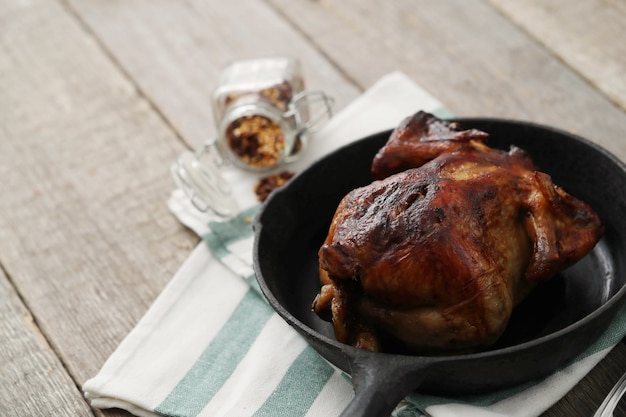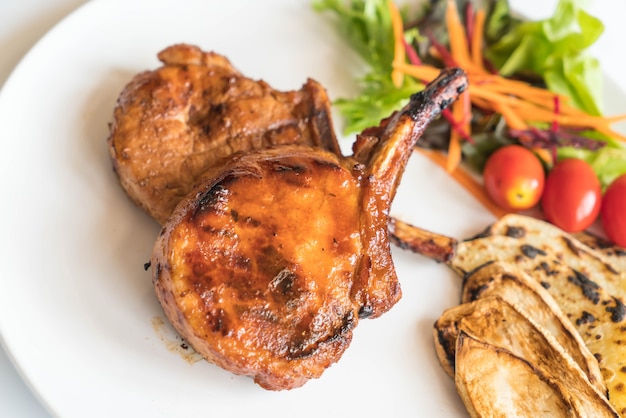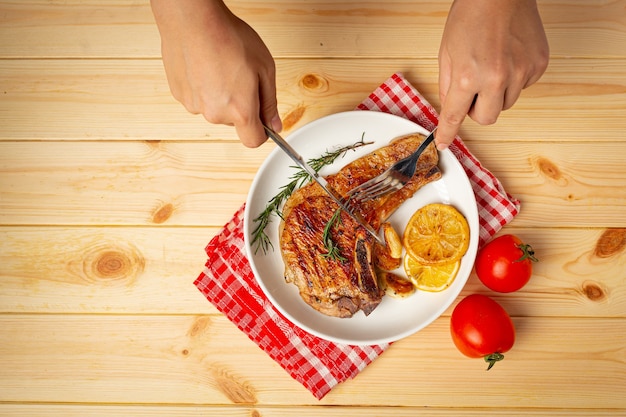Let's be honest, pork shoulder gets a bit of a bad rap. It's often seen as the 'cheap' cut, relegated to the back of the fridge, waiting for its chance to become pulled pork. But I'm here to tell you that pork shoulder is a true culinary hero, capable of producing some of the most tender, succulent, and flavourful meals.
Forget the bland, dry roast dinners of the past. We're talking about a journey of transformation, where a humble cut of meat becomes a symphony of flavour, meltingly tender and full of juicy goodness. And the best part? It's incredibly versatile, adaptable to a range of cooking styles and flavour profiles.
I'm going to take you on this journey, sharing my secrets and tips, gleaned from years of experimenting and perfecting my own pork shoulder recipes. You'll learn how to choose the perfect cut, prep it for success, cook it to perfection, and transform it into a culinary masterpiece.
Grab a cuppa, get comfortable, and let's get started. It's going to be a delicious ride!
(Part 1) Choosing Your Pork Shoulder: Boston Butt vs Picnic Shoulder

The first step is understanding the two main types of pork shoulder: the Boston Butt and the Picnic Shoulder. It's like choosing between two great friends, each with their own unique charm.
The Boston Butt: The Lean and Tender Choice
The Boston Butt might sound a bit confusing, but it's actually the top part of the shoulder. This makes it slightly more tender and leaner than its cousin, the Picnic Shoulder. It also tends to have a more consistent shape, making it a little easier to cook. The only downside? It's often a bit more expensive.
The Picnic Shoulder: The Full-Flavored Option
The Picnic Shoulder, on the other hand, is the lower part of the shoulder, including a bit of the leg. It tends to be tougher and has more fat, but it's also full of flavour, thanks to the interplay of muscle and fat. The best part? It's generally more affordable.
My Personal Preference
I'm a big fan of both, but if I had to choose, I'd go for the Boston Butt for its tenderness and leanness. But honestly, it all comes down to personal taste and budget.
(Part 2) Prepping Your Pork Shoulder: Setting It Up For Success

Now that you've chosen your champion, let's get it prepped. This is where you turn that ordinary piece of meat into a culinary masterpiece. It's a bit of a transformation, and it's well worth the effort.
1. Seasoning: A Rub of Love
The first step is to give your pork shoulder a good rub. Think of it as a spa treatment for your meat. I'm a big fan of a simple salt and pepper rub, but don't be afraid to get creative. A touch of paprika, garlic powder, onion powder, or even a pinch of chili flakes can add a whole new dimension of flavour.
Remember, the key is to rub it generously all over, ensuring every inch is coated in flavour.
2. Fat Trimming: The Art of Balance
Next comes fat trimming. Now, let's be clear, fat is flavour! We don't want to completely remove it. But you do want to trim away any excess fat, especially the thickest pieces. This will help the roast cook more evenly and prevent it from becoming greasy.
The goal is to find that perfect balance, where you retain enough fat for flavour, but not so much that it hinders cooking.
3. Tie It Up: Maintaining Shape and Evenness
If you're working with a larger pork shoulder, you might want to tie it up with butcher's twine. This helps maintain its shape during cooking, ensuring it cooks evenly. Simply tie it at regular intervals, making sure it's nice and snug.
(Part 3) Cooking Methods: Slow and Steady Wins the Race

Here's the secret to unlocking the true potential of pork shoulder: slow and low cooking. We're not talking about rushing the process. We're talking about gentle, low heat cooking that allows the meat to break down and become meltingly tender.
Think of it like this: We're not just cooking the pork, we're transforming it.
1. The slow cooker: Effortless Excellence
The slow cooker is your best friend for a hands-off, incredibly delicious pork shoulder. Just season your roast, pop it in the slow cooker, add some liquid (like broth or apple cider), and let it cook on low for 6-8 hours. It's practically foolproof, letting you go about your day while the pork shoulder does its magic.
2. The Oven: A Reliable Choice
The oven is another reliable option for achieving a perfectly cooked pork shoulder. Preheat it to 325 degrees F (160 degrees C), place your roast in a roasting pan, and cover it with foil. Cook for 4-5 hours, or until the internal temperature reaches 190 degrees F (88 degrees C). Remove the foil for the last hour to allow the skin to crisp up.
3. The Smoker: For That Smoky, BBQ Flair
If you're feeling adventurous, try cooking your pork shoulder in a smoker. This method will infuse it with a smoky, BBQ-style flavour that's truly irresistible. Just rub it with your favourite BBQ rub, set the smoker to 225 degrees F (110 degrees C), and cook for 6-8 hours, or until it reaches an internal temperature of 190 degrees F (88 degrees C).
(Part 4) Know When It's Done: Temperature is King
Remember, when it comes to pork shoulder, time alone isn't the deciding factor. Temperature is key. Always use a meat thermometer to check the internal temperature. We're aiming for 190 degrees F (88 degrees C) for the most tender and juicy results.
You'll know it's ready when the meat is so tender that it practically falls apart when you pull on it. It's a testament to patience and dedication, and it's worth every moment of waiting.
(Part 5) Resting: Letting the Pork Relax and Recover
Your pork shoulder has just undergone a culinary transformation. It's worked hard, and it deserves a chance to relax. Let it rest for at least 30 minutes, covered in foil. This allows the juices to redistribute throughout the meat, making it even more tender and flavorful.
Think of it as a spa day for your pork shoulder. It's all about letting it unwind, so it can truly shine on your plate.
(Part 6) Shredding: Transforming Your Roast into Culinary Gold
The moment has arrived. It's time to shred that beautiful pork shoulder! You can use two forks to pull the meat apart, or if you're feeling adventurous, try using your hands for a more rustic approach. It's a satisfying part of the process, getting hands-on with your creation.
As you shred, you'll notice a delicious liquid pooling at the bottom of the pan. Don't waste it! Save it and use it to make a sauce or gravy, or even mix some back in with the shredded pork for extra flavour. It's the essence of your pork shoulder, a flavour bomb waiting to be unleashed.
(Part 7) Serving Up Your Pork Shoulder Masterpiece: A Feast for the Senses
You've invested time and effort, and now it's time to reap the rewards. There are endless possibilities when it comes to serving your perfectly cooked pork shoulder. Here are a few ideas to get your creative juices flowing:
1. pulled pork sandwiches: A Classic Done Right
This is a classic for a reason. Pile the shredded pork onto a soft bun, add some tangy coleslaw, and a drizzle of your favourite bbq sauce. It's a crowd-pleasing dish that never disappoints.
2. Pork Tacos: A Mexican Twist
Add a Mexican twist by serving your pork shoulder in tacos. Top with your favourite toppings like pico de gallo, guacamole, salsa, and sour cream. It's a quick and easy way to enjoy your pork shoulder.
3. Pork Nachos: A Tower of Flavour
Create a mountain of nachos with tortilla chips, shredded cheese, and your delicious pork shoulder. Add all your favourite toppings and get ready for a delicious and satisfying snack or meal.
4. Pork Bowls: A Wholesome and Balanced Meal
For a more wholesome option, serve your pork shoulder in bowls with rice, beans, and your favourite vegetables. It's a great way to make a balanced and flavourful meal.
(Part 8) Recipe Time: A Few of My Favourites
Let's get our hands dirty! Here are a few of my favourite recipes that showcase the amazing versatility of pork shoulder.
1. Slow Cooker BBQ Pulled Pork: A Simple and Satisfying Classic
Ingredients:
- 3-4 lb pork shoulder, boneless
- 1 cup BBQ sauce
- 1/2 cup apple cider
- 1 onion, chopped
- 2 cloves garlic, minced
- Salt and pepper to taste
Instructions:
- Rub the pork shoulder with salt and pepper.
- Place the pork shoulder in the slow cooker.
- Add the BBQ sauce, apple cider, onion, and garlic.
- Cook on low for 6-8 hours, or until the pork is tender.
- Shred the pork and serve on buns with your favourite toppings.
2. Honey Garlic Pork Shoulder Roast: Sweet and Savoury Perfection
Ingredients:
- 3-4 lb pork shoulder, boneless
- 1/4 cup honey
- 1/4 cup soy sauce
- 2 tablespoons brown sugar
- 2 cloves garlic, minced
- 1 tablespoon ginger, grated
- Salt and pepper to taste
Instructions:
- Preheat oven to 325 degrees F (160 degrees C).
- In a small bowl, whisk together the honey, soy sauce, brown sugar, garlic, and ginger.
- Rub the pork shoulder with the honey-garlic mixture.
- Place the pork shoulder in a roasting pan and cover with foil.
- Roast for 4-5 hours, or until the pork is tender and reaches an internal temperature of 190 degrees F (88 degrees C).
- Remove the foil for the last hour to allow the skin to crisp up.
- Serve with your favourite sides.
3. smoked pork shoulder with Carolina Mustard Sauce: A Smoky, Tangy Treat
Ingredients:
- 3-4 lb pork shoulder, boneless
- 1/2 cup apple cider vinegar
- 1/4 cup brown sugar
- 1/4 cup yellow mustard
- 1 tablespoon paprika
- 1 tablespoon garlic powder
- 1 tablespoon onion powder
- 1 teaspoon black pepper
- 1 teaspoon salt
Instructions:
- In a small bowl, whisk together the apple cider vinegar, brown sugar, mustard, paprika, garlic powder, onion powder, pepper, and salt. This is your Carolina Mustard Sauce.
- Rub the pork shoulder with the sauce and place it in your smoker.
- Set the smoker to 225 degrees F (110 degrees C) and cook for 6-8 hours, or until the pork is tender and reaches an internal temperature of 190 degrees F (88 degrees C).
- Remove the pork from the smoker and let it rest for 30 minutes before shredding.
- Serve the shredded pork with additional Carolina Mustard Sauce, or on buns with your favourite toppings.
(Part 9) Tips and Tricks: Mastering the Art of Pork Shoulder
Here are a few extra tips to help you become a pork shoulder master:
- Don't be afraid to get creative with seasoning: Experiment with different herbs and spices to add depth of flavour to your pork shoulder.
- Keep an eye on the temperature: A meat thermometer is your best friend for ensuring your pork shoulder is cooked to perfection. Don't rely solely on time.
- Don't overcook: Once your pork shoulder reaches an internal temperature of 190 degrees F (88 degrees C), it's done. Overcooking will make it dry and tough.
- Rest, rest, rest: Allowing the pork shoulder to rest for 30 minutes after cooking will help to redistribute the juices and ensure it's incredibly tender.
- Use the leftover juices: Don't throw away the delicious juices that accumulate in the bottom of the pan! Use them to make a sauce or gravy for your pork shoulder.
- Prepare ahead: You can prepare your pork shoulder in advance and store it in the fridge for up to 2 days before cooking. Just make sure to bring it to room temperature before cooking.
(Part 10) FAQs: Common Questions About Pork Shoulder
You've got questions, I've got answers. Here are some frequently asked questions about pork shoulder:
1. Can I use frozen pork shoulder?
It's best to use fresh pork shoulder for the most tender and flavorful results. But if you're in a pinch, you can definitely use frozen pork shoulder. Just make sure to thaw it completely in the fridge before cooking.
2. What if my pork shoulder is a bit dry?
If your pork shoulder turns out a bit dry, don't despair! You can add some moisture by adding some broth or apple cider to the pan while it's cooking. You can also serve it with a sauce or gravy to help moisten it up.
3. How do I store leftover pork shoulder?
Leftover pork shoulder can be stored in an airtight container in the fridge for up to 4 days. It can also be frozen for up to 3 months. Just make sure to reheat it thoroughly before serving.
4. Can I use different cuts of pork for this recipe?
While pork shoulder is the best cut for slow cooking and shredding, you can also use other cuts of pork, like pork loin or pork tenderloin. Just keep in mind that these cuts will cook faster and may need to be adjusted for time and temperature.
5. Can I use a different type of sauce?
Absolutely! The beauty of pork shoulder is that it's incredibly versatile and pairs well with a variety of sauces. Experiment with your favourite BBQ sauces, marinades, or even Asian-inspired sauces. Just make sure to adjust the cooking time and temperature accordingly.
(Part 11) Final Thoughts: Pork Shoulder, Your New Culinary Hero
You've made it to the end of this journey. You're now equipped to conquer the world of pork shoulder, from choosing the perfect cut to mastering the cooking techniques, and transforming it into a culinary masterpiece that will impress your friends and family.
So next time you're looking for a delicious and satisfying meal, give pork shoulder a try. You might just discover your new favourite cut of meat!
Bonus Tip: The Power of a dutch oven
While the slow cooker and oven are excellent choices, there's another method that's quickly become a favourite in my kitchen: the Dutch oven. It's like a marriage between the slow cooker's ease and the oven's versatility.
Simply sear your seasoned pork shoulder in a Dutch oven over medium-high heat, then transfer it to a preheated oven (325 degrees F/160 degrees C) and cook it for 4-5 hours. It's a delicious way to get a nice crust on the outside while achieving that melt-in-your-mouth tenderness.
And there you have it, a complete guide to unlocking the deliciousness of pork shoulder. Now, get out there and start creating culinary magic!
Everyone is watching

How to Cook Frozen Lobster Tails Perfectly: A Step-by-Step Guide
RecipesLobster. Just the word conjures up images of lavish meals, special occasions, and a taste of luxury. But let's...

Pigs in a Blanket Cooking Time: How Long to Bake for Perfect Results
RecipesAh, pigs in a blanket. Just the name conjures up images of those delightful little parcels of crispy pastry en...

Pork Fillet Cooking Time: How Long to Cook It Perfectly
RecipesPork fillet, or tenderloin as it's sometimes called, is a real favourite in our house. It's so versatile, and...

The Ultimate Guide to Tender, Juicy Pulled Pork
RecipesRight, let's talk pulled pork. It's one of those dishes that just screams "comfort food," doesn't it? I mean...

The Ultimate Guide to Cooking Delicious Frankfurters
RecipesLet's face it, we all love a good frankfurter. It's a classic, simple, and always satisfying. But let's be rea...
